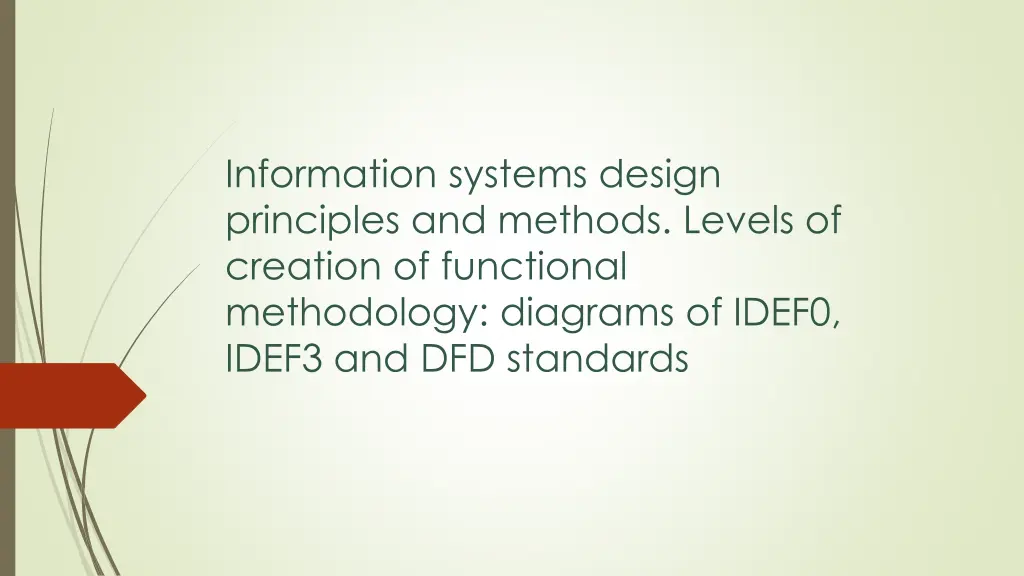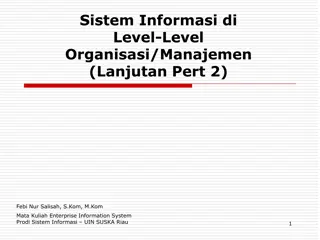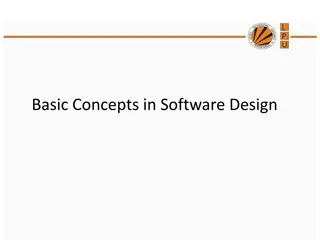
Functional Methodology in Information Systems Design
Explore principles and methods in Information Systems Design (ISD) focusing on modularity, abstraction, and encapsulation. Learn how these concepts contribute to easier maintenance, testing, scalability, and code reusability in system development.
Download Presentation

Please find below an Image/Link to download the presentation.
The content on the website is provided AS IS for your information and personal use only. It may not be sold, licensed, or shared on other websites without obtaining consent from the author. If you encounter any issues during the download, it is possible that the publisher has removed the file from their server.
You are allowed to download the files provided on this website for personal or commercial use, subject to the condition that they are used lawfully. All files are the property of their respective owners.
The content on the website is provided AS IS for your information and personal use only. It may not be sold, licensed, or shared on other websites without obtaining consent from the author.
E N D
Presentation Transcript
Information systems design principles and methods. Levels of creation of functional methodology: diagrams of IDEF0, IDEF3 and DFD standards
Information Systems Design (ISD) involves the process of defining the architecture, components, modules, interfaces, and data for a system to satisfy specified requirements. There are several principles and methods involved in ISD, along with various standards and methodologies for creating functional diagrams. Let's explore them
1-Modularity: Designing the system in a modular fashion allows for easier maintenance, testing, and scalability Easier Maintenance: With modular design, each module is responsible for a specific function or feature, making it easier to identify and fix issues without affecting other parts of the system. Testing: Modular systems allow for more focused testing. Each module can be tested individually, ensuring that it functions correctly in isolation before being integrated into the larger system. Scalability: Modularity facilitates scalability by allowing components to be added, removed, or replaced without impacting the entire system. This makes it easier to adapt the system to changing requirements or handle increased loads. Code Reusability: Modular design promotes code reuse, as modules can be reused across different parts of the system or even in other projects, reducing development time and effort.
2- Abstraction: Breaking down complex systems into manageable and understandable components. Simplicity: Abstraction simplifies the understanding of complex systems by focusing on essential features and hiding implementation details. This makes it easier to manage and reason about the system. Modularity: Abstraction facilitates modularity by allowing components to interact through well-defined interfaces, without needing to understand the internal workings of each component. Reusability: Abstraction promotes code reuse by encapsulating functionality into reusable components or modules. These components can be used across different parts of the system or even in other projects, saving time and effort in development. Scalability: Abstraction helps in scaling systems by providing clear boundaries between components, allowing them to be independently developed, tested, and optimized.
3-Encapsulation: Hiding the internal workings of a module while providing well-defined interfaces. Data Hiding: Encapsulation hides the internal state of an object from the outside world. By making data private or protected within a class, you prevent direct access to it from outside the class. This ensures that the object's state can only be modified through the methods provided by the class, which helps maintain data integrity and prevents unintended manipulation. Well- Defined Interfaces: Encapsulation provides well-defined interfaces through which external code can interact with an object. These interfaces consist of public methods that expose the object's behavior while abstracting away its implementation details. By defining clear boundaries between the internal implementation and the external interface, encapsulation promotes modular design and reduces coupling between different parts of the system. Information Hiding: Encapsulation also enables information hiding, which means that the internal implementation details of an object are hidden from other parts of the system. This allows developers to modify the internal implementation of a class without affecting other components that depend on it, as long as the external interface remains unchanged.
4- Decomposition: Breaking down the system into smaller, more manageable parts to simplify design and implementation. Simplification: Breaking down a complex system into smaller parts makes it easier to understand and work with. Each component can be designed, implemented, and tested independently, reducing the overall complexity of the project. Modularity: Decomposition promotes modularity by dividing the system into cohesive modules or components. Each module is responsible for a specific aspect of the system's functionality, which makes it easier to maintain, update, and reuse code. Encapsulation: Decomposition facilitates encapsulation by defining clear boundaries between different parts of the system. This allows developers to hide the internal details of each component, exposing only the necessary interfaces for interaction with other components. Parallel Development: Decomposing a system into smaller parts enables parallel development, where different teams or individuals can work on separate components simultaneously. This can significantly reduce development time and improve overall productivity. Scalability: Decomposition enables the system to scale more effectively. By breaking down the system into smaller parts, it becomes easier to add new features or accommodate changes in requirements without affecting the entire system.
5. Layering: Organizing components into layers, each responsible for a specific set of functions, promoting reusability and separation of concerns. Separation of Concerns: Layering separates different concerns or responsibilities of the system into distinct layers. Each layer focuses on a specific aspect of functionality, such as presentation, business logic, and data access. This separation makes the system easier to understand, maintain, and modify. Modularity and Reusability: By organizing components into layers, the system becomes more modular. Each layer encapsulates related functionality, making it easier to reuse components across different parts of the system or in other projects. This promotes code reusability and reduces duplication of code. Abstraction: Layering abstracts away the complexities of the underlying system by providing clear interfaces between layers. Each layer interacts with adjacent layers through well- defined interfaces, hiding implementation details and reducing dependencies between layers. Scalability: Layering facilitates scalability by allowing the system to be scaled horizontally or vertically. New layers can be added to accommodate additional functionality or to improve performance without affecting other layers. Flexibility: Layering provides flexibility in system design and architecture. Developers can choose to add or remove layers as needed, depending on the requirements of the system. This flexibility makes it easier to adapt the system to changing business needs or technological advancement
6-Data Integrity: Ensuring the accuracy, consistency, and reliability of data throughout the system. Accuracy: Data accuracy ensures that the information stored in the system is correct and reflects the real-world entities it represents. This involves validating input data, enforcing constraints, and performing data validation checks to prevent incorrect or invalid data from being stored. Consistency: Data consistency ensures that the data remains coherent and synchronized across all parts of the system. This involves enforcing referential integrity constraints, transaction management, and concurrency control mechanisms to prevent data anomalies such as lost updates, dirty reads, and inconsistent states. Reliability: Data reliability ensures that the data can be trusted and relied upon for decision-making and business operations. This involves implementing backup and recovery strategies, redundancy, and fault- tolerant mechanisms to ensure data availability and durability, even in the event of system failures or disasters. Security: Data integrity also encompasses data security, which involves protecting data from unauthorized access, tampering, and corruption. This involves implementing access control measures, encryption, authentication, and auditing mechanisms to safeguard sensitive data from malicious attacks and unauthorized modifications. Compliance: Data integrity is essential for regulatory compliance, ensuring that the system adheres to legal and industry-specific standards for data protection, privacy, and auditing. This involves implementing data governance policies, data retention policies, and compliance monitoring mechanisms to ensure that the system meets the required standards and regulations.






















